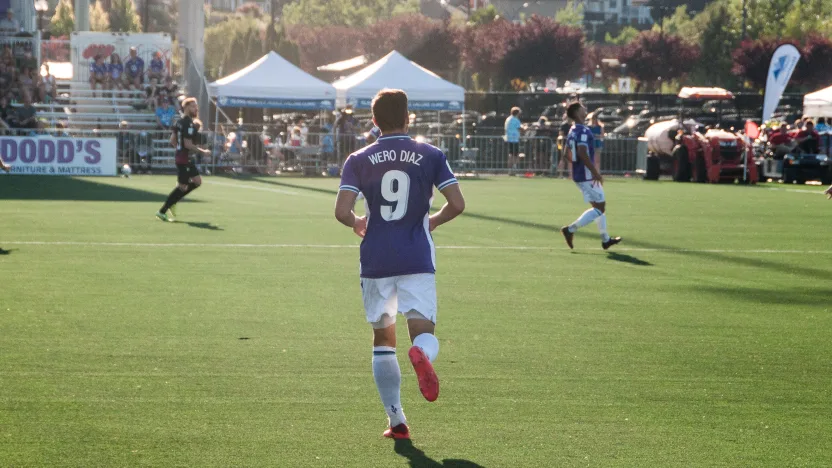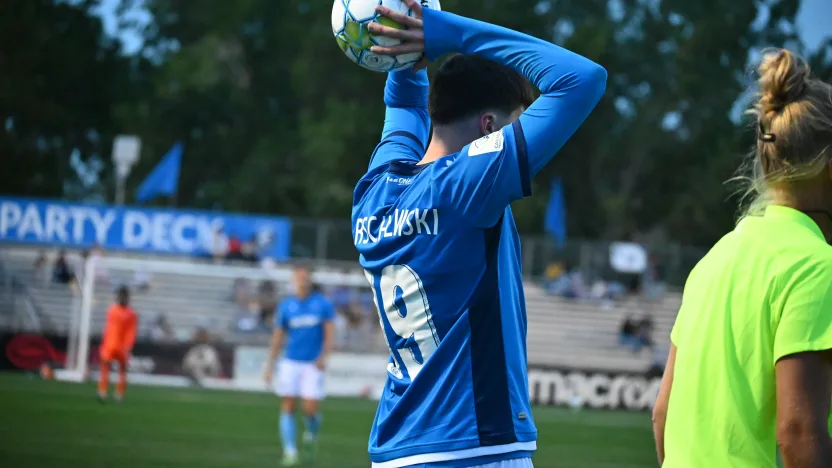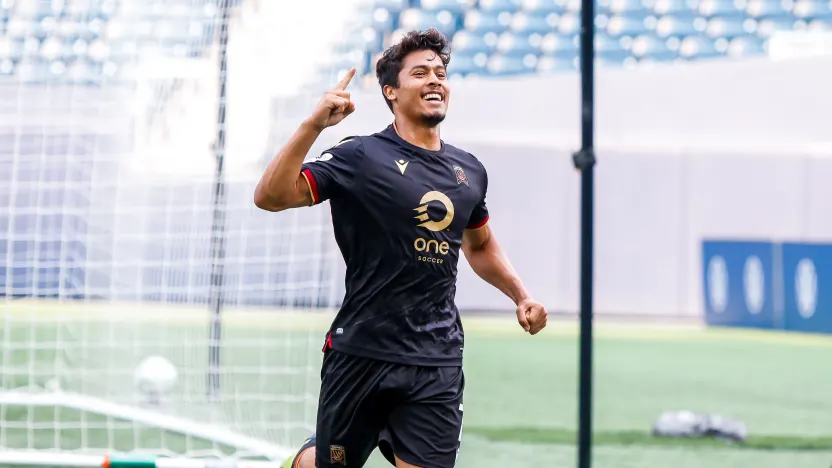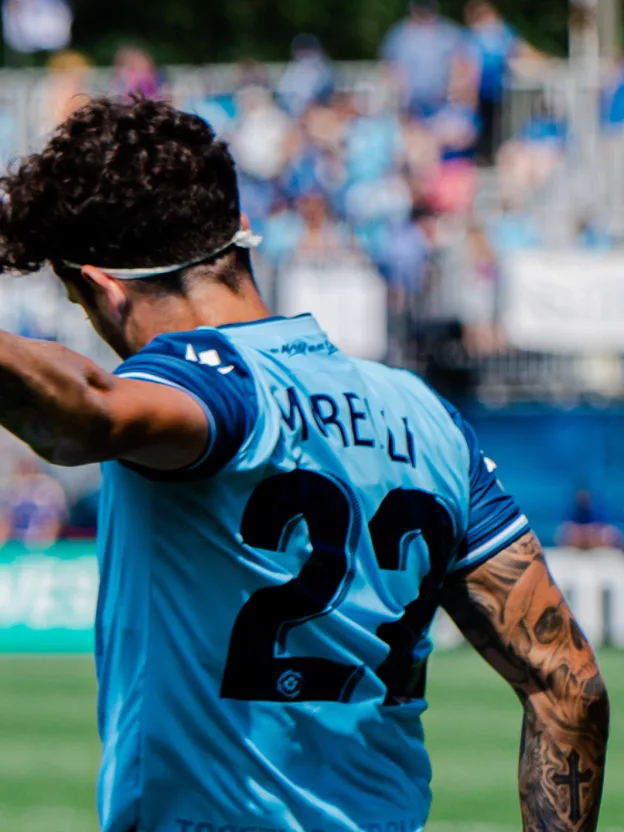Since day one, the Canadian Premier League has been about the growth of soccer in Canada — developing young talent, bringing the sport to more fans across the country, and broadly improving the health of the game in as many ways as possible. That much has always been clear, and it’s why the core of the CPL’s playerbase is, and always will be, Canadian. However, it doesn’t take long while watching a CPL match in 2021 to realize that — much like this country itself — talent from all over the world has also come to make a massive impact and contribute to the improving standard of play. This year’s Golden Boot winner, for instance, is Brazilian forward Joao Morelli of HFX Wanderers FC. Daan Klomp, a Dutch defender for Cavalry FC, has been a constant fixture in the Gatorade Team of the Week. In addition to Morelli, three other international players — Alejandro Díaz (Pacific), Moses Dyer (Valour), and Álvaro Rivero (York United) — were the top, or joint-top, scorer on their team this season, and FC Edmonton’s Tobias Warschewski led the CPL in assists.
RELATED: Beyond the Pitch: HFX Wanderers forward João Morelli || OneSoccer: Centre-back Daan Klomp proving a hit for Cavalry FC
And the thing that connects all six of those players? Each of them was 24 years old or younger when they signed in the CPL. The league hasn’t always had this level of contribution from young internationals, though. When building squads for the inaugural season in 2019, many clubs opted to spend resources for their foreign contingent (each club is allotted seven international spots on the roster) on older, more experienced players, many of whom struggled to make an impact in the league. Of course, there are several reasons for incorporating internationals into the CPL fold. Players can definitely bring their vast experience in the game back to Canada, having seen it in its myriad forms around the world — although in 2019, the best two sides in the CPL (Forge and Cavalry) were led by Canadian veterans like Nik Ledgerwood, Mason Trafford, Kyle Bekker, and David Edgar, who played abroad and came home. “The experience that those guys have, having come through the Canadian system, knowing what the obstacles and challenges and pitfalls are, they’re going to be able to understand the young players of today much better than an international player who comes in, who may not speak the language, or has a clue about what the Canadian football landscape is,” explained CPL VP of Football Operations James Easton. Still, there’s value in diversity of experience and upbringing; players coming in from academies around the world have plenty to offer young Canadians. What gives the edge to young international newcomers, though, is player sales. “A thing that we were very cognizant of right from the beginning, which a lot of North Americans don’t understand, is this idea that in order to make this whole thing spin, we also have to start using this fourth revenue stream, which is very different from any of the other North American sports, which is player transfers and player sales,” the CPL’s Director of Football, Oliver Gage, told CanPL.ca. “In those other sports you either get cut or traded, whereas in football you can get cut or traded, or you get bought. We really need to kind of jumpstart and stimulate that.”

It’s never been a secret that the CPL wants to be a selling league. As Gage pointed out, most leagues in the world are — the only real exceptions being the English Premier League and Spain’s La Liga. Of course, many of the players that end up moving on will be the young Canadians around whom the CPL is built, just like Joel Waterman, Tristan Borges, and others did in 2019. However, young players from abroad can also use the CPL as their stepping-stone to big transfers, as other leagues (including MLS) have seen. “I think we would be disappointed as a league if any player in our league currently — a young player in our league — wants this to be their final destination,” Gage added. “We want all of our Canadians to move to bigger and better, and I think the same goes with the internationals. And the same goes with our coaches, we want to be that platform right now. How many leagues in the world aren’t selling leagues? So we have to accept that we’re a league that’s gonna lose some of our best for the right reasons. I think if you look a bit further than one season out, it’s a positive thing for the league.” So, after the 2019 season, Gage and Easton set to work. The international contingent in the CPL, to that point, hadn’t been quite what they’d imagined, with quite a few players taking professional contracts away from Canadian players and offering little in return. Enter the partnership with Twenty First Group. The league teamed up with the international sports intelligence agency to help create a database for CPL teams to aid in international scouting and recruitment. “We thought it was an opportunity to do that with young international players if we were very selective, and targeted, and proactive in our approach,” Easton said. “You’re not going to find the sort of value that you covet in the already lighted places; you’ve got to go into the darkness, you’ve got to go into the shadows to find those gems and those undervalued assets. This is what this program is really all about, and doing it more on a league-wide basis as opposed to leaving it to the individual clubs or coaches to go out and find that. We want it to be a league-driven, club-driven process as opposed to an agent-driven initiative.” Warschewski, for instance, was in the German fourth tier. Dyer, a New Zealand-born striker, was playing in Norway’s third flight. Even Morelli had been playing in Estonia, after leaving the academy of Middlesbrough in England. Essentially, Twenty First Group’s detailed profiles on almost every professional player in the world allow the CPL and its clubs to compare players — leagues are rated against one another using an Elo ranking system. So, analysts within the league’s football development department can identify players who might be a fit in the CPL and make contact with them, trying to gauge interest and working out the basic details of a potential contract (“90% of the way there,” Gage suggested), before presenting their list to clubs to work out the rest individually with the players they’re interested in. On the flip side, if clubs find players on their own through various contacts and networks, they can still make use of the 21st Club database and put the player into the league’s algorithm to evaluate how they might compare to others in the list of players previously identified by the league.

From an international player’s perspective, the system works for them, too. Players all over the world are more likely to be identified by the CPL and connected to clubs in Canada, which is quite a popular destination for players from certain countries, where — in some cases — the quality of life and stability might not be the same as it is here. Plus, the CPL’s broadcast setup with MediaPro and OneSoccer shouldn’t be undervalued; there are many leagues around the world where, even if the quality of football or average salary is slightly higher, players have less opportunity to be seen and earn their next move up the ladder. “Anybody who wants to move on up to a higher, more established league, having your games on and filmed in a fashion as they do with MediaPro and OneSoccer allows them to build a catalogue of their work and share, and be seen in ways that you can’t do if you’re playing (elsewhere),” Easton explained. So, the league has been able to convince some talented young players from all over the world, many of whom have been looking for a place to get their careers back on track, to come to Canada and play for a CPL club. And by those players — the Joao Morellis, the Daan Klomps, and so on — having success in the CPL, and perhaps one day getting an upward transfer, the league can then attract the next crop of young internationals. “The theory is kind of undeniable, right?” Gage said. “If you think that players are better when they’re older, which is debatable, then any player brought in through this program is gonna be better in year two and three than they are in year one when they arrive, if you back our coaches to make players better. But again, if you’re signing a 28-year-old, he’s gonna be declining at that point. If you’re signing a 22-year-old, he’s only improving at that point. Unless it’s a very win-now mentality, which is fair, but I don’t think this league currently is 100% win now.” From a competitive standpoint within the CPL, the league felt it was important to ensure a level playing field when it comes to signing and giving minutes to young foreign players. Clubs have been encouraged to make use of the Twenty First Group database, and by requiring that teams sign such players (each club has to have at least four league-approved players on their roster), Gage believes coaches and owners can invest in them more freely. When the new recruitment program came into being after the 2019 season, some CPL teams already had international players that fit the bill. Others, though, needed a nudge in the right direction. “It’s providing (teams) an environment where they can make these types of signings without feeling risk,” he explained. “If you kind of take all the rules away, coaches feel like they have to sign older players to win games because they’re more reliable and all the rest of it, and that’s why you have to do it if it’s an even playing field, because if you sign a young guy and someone else signs an old guy, they’ve got an opportunity over you. But if everybody has to sign young guys, then you’re back to square one where everybody is competing on the same set of rules. It’s about you doing better work with your young guys than them doing better work with their young guys.” He added: “It’s about creating an environment where coaches feel that by signing a young player, they’re not going to lose games and get fired. Because in that situation, I might go for older players too… If we provide the environment where it’s safe to sign young players, and every club is operating on the same set of rules, then it’s just about who’s the best coach again.”

From a certain perspective, Gage said he understands where people are coming from in criticizing the idea of rules and centralized systems for player recruitment; in an ideal world, clubs will one day be able to scout, sign, develop, and sell international players autonomously. At the moment, though, with limited resources and manpower, it’s been important that the league provide teams with the ability to get there. “I don’t see this being in place in two years time, three years time or five years time,” Gage suggested. “In theory, the clubs will hopefully be doing this on their own in a few years’ time, and they’ll have data analysts and whatever it is, and we won’t be needed. I always joke around and say my job is to get the clubs into a position where I’m no longer needed and I don’t have a job anymore.” Easton added: “As they build that capacity, then that allows us from a league perspective to kind of shift out or take a step back from that and give them greater autonomy. But to all these points, one of the things we really wanted to do was nudge them toward the profile of types of players that we wanted, and this is really a large part of shifting or changing that approach, or shifting the identity of the league a little bit when it came to the type of players we wanted to recruit for sure.” Ultimately, when you build a league from the ground up, there are going to be growing pains. The CPL had its fair share of them in 2019 — not only were some players in their first professional environment, but so too were plenty of the league’s coaches and staff. It makes sense that systems would be tweaked and refined to help put things on track. Plus, the CPL’s Football Development department is more free to focus on the bigger, long-term picture rather than the wins and losses. “We come at this from a very different perspective to individual coaches or individual teams,” Easton explained. “Their time horizon is three games; they’ve got to keep winning the next three games and do well in those three games… The league’s perspective is 10 years out. We want to be a top three league in Concacaf by 2026, or shortly thereafter; certainly within the next decade. We have developed a strategy for how we get from where we are today to that position.” There is plenty of work to be done — with this system still in the early days, we still have yet to see that final step, where players move on after their success in the CPL, but the encouraging signs are there. And as the quality of play in the CPL continues to improve, so too will its Canadian players.
